
Digital product management A structured approach to product innovation and governance
12 minute read
18 October 2019
In an Industry 4.0 environment, many companies struggle with new product development. This article, seventh in a series, discusses how leaders can link innovation processes to strategy and business model transformation.
Introduction
Companies preparing for Industry 4.0 operate in an environment that is evolving more rapidly than ever.1 As new entrants and technologies disrupt once-steady growth, the average tenure of a company on the S&P 500 has dropped 80 percent, from 67 years to 15 years.2 “In a rapidly changing world,” says Deloitte’s Center for the Edge cochairman John Seely Brown, “innovation and agility must reign supreme,”3 and launching new products is where companies’ innovation and agility meet the marketplace.
Learn more
Explore the Digital transformation collection
Explore more on Industry 4.0
Download the Deloitte Insights and Dow Jones app
Subscribe to receive more related content
Though product innovation is an Industry 4.0 hallmark, many companies struggle to execute.4 According to a Deloitte Global survey measuring business and government readiness for Industry 4.0, when asked what topics C-suite level executives discuss most frequently as an organization, 57 percent of survey respondents put developing and creating new products at the top.5 And many blame failure to innovate effectively on organizational inertia—focusing on protecting the current state while avoiding or delaying responses to marketplace disruptions.6 Considering the often-troubled innovation process, it should be no surprise that 43 percent of new product launches fail to meet one or more of their targeted business goals.7
When asked what topics C-suite level executives discuss most frequently as an organization, 57 percent of survey respondents put developing and creating new products at the top.
These forces are putting greater pressure on companies to innovate both faster and more effectively, a particular challenge for organizations going through digital transformations. And though a growing number of companies are investing in various external means of product innovation—corporate venture capital, incubators, accelerators, capability-driven M&A, partnerships8—the ability to internally develop and launch successful products and services remains paramount.
Earlier in this series, we introduced the digital industrial transformation framework (figure 1).9 Among the most critical capabilities companies need are product innovation, management, and development—the ability to rapidly churn out products, solutions, and services that meet the needs of both existing and new customers, and to do it in a way that won’t blow the budget given the other challenges to which executives must dedicate talent and capital. As such, we must discuss the advantages of digital industrial transformation at the product level. This article directly addresses the fifth box of this series’ framework: people, process, and technology. Specifically, we discuss how companies can become more effective at managing innovation within their proverbial four walls by linking their innovation processes and governance to strategy and business model choices—and leveraging existing capabilities and operating model.
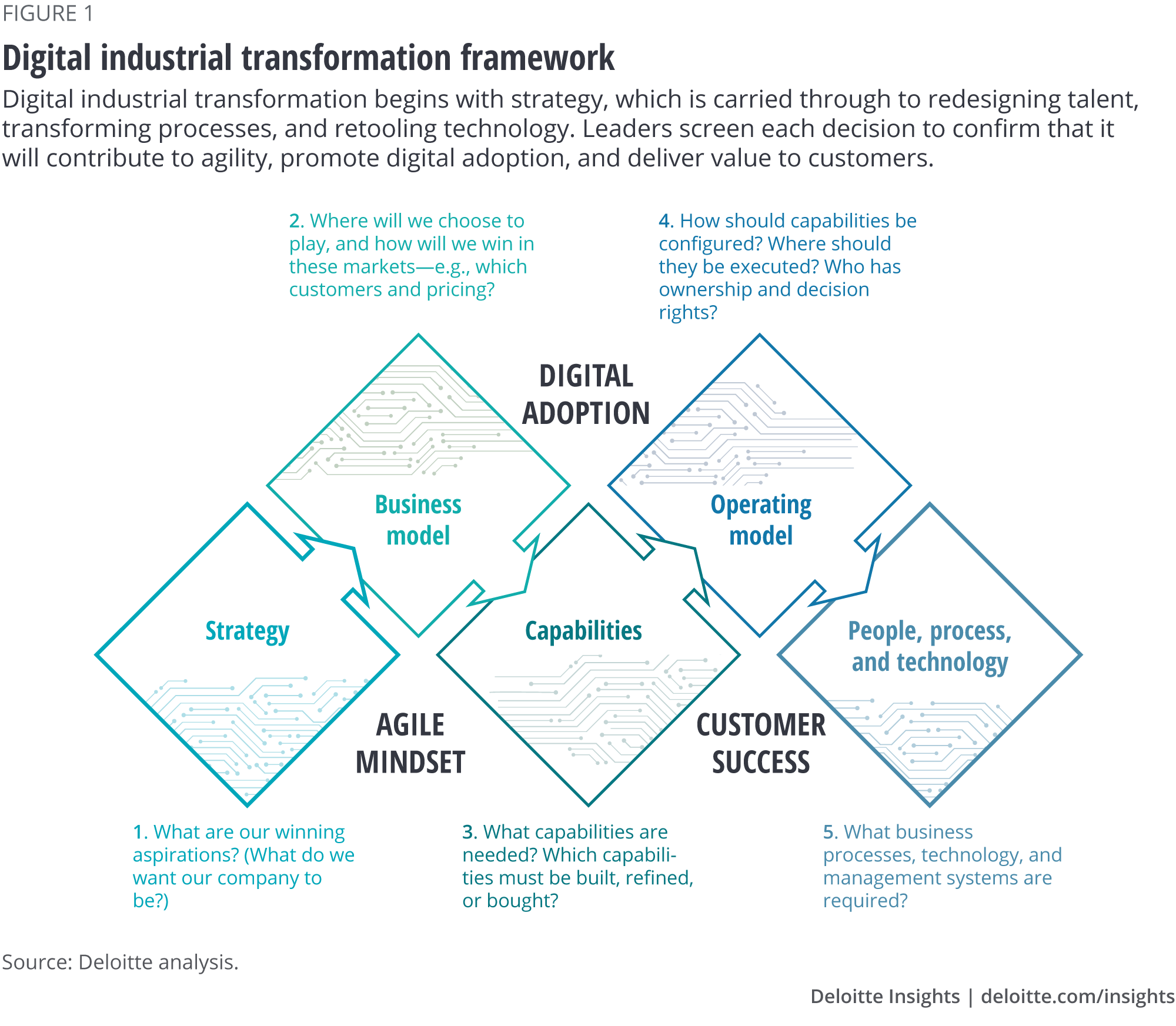
Transforming product innovation
To accelerate internal product innovation, many leading companies have revisited how they develop and introduce new products and services—infusing innovation with consistent processes, transparent decision-making, and organizational structure. For example:
- Amazon employs a process of “working backwards,” which begins with five customer questions: Who is the customer? What is the problem/opportunity? What is its most important benefit? How do you know what the customer needs/wants? And what does the customer experience look like? Based on the answers, a press release, FAQ list, and “portrayal of the customer experience” are built to illustrate the idea and how it will positively affect customers.10
- Google created a separate R&D organization, X, to pursue moonshot ideas—for example, self-driving cars and delivering internet via balloon.11
- A global software company reviews new products and major releases with cross-functional executive teams, enforcing go/no-go decisions at multiple checkpoints.
It is worth noting that companies may engage in types of innovation beyond product—profit model, business process, channel, etc.12 Upcoming articles in this series will tackle other forms of innovation, including through cocreation (with customers, partners, and competitors), as well as the other components of building innovative organizations—the people and technology.
A structured approach to product innovation
Companies that innovate effectively are skilled at harnessing product ideas from a variety of sources, both internal and external. Internally, executives and employees in different areas—such as business units or the R&D organization—often generate new ideas based on their particular knowledge of the product, market, and customers. Externally, customers are a key source of product innovation, through feedback on and identification of pain points, desired features, and new use cases. Partners, competitors, distributors, suppliers, and advisers can also serve as a source of inspiration. Moreover, many companies are now shifting toward open innovation—innovation that takes place in collaborative ecosystems that leverage both internal and external ideas and capabilities.13
In short, good ideas are plentiful. Companies that have a track record of innovation focus on how best to channel, evaluate, and execute the best of those ideas.
No matter where your ideas come from, having a customer-centric lens is increasingly important for maintaining a competitive edge, driving growth, and increasing revenue.14 According to research firm Forrester, “The only source of competitive advantage is the one that can survive technology-fueled disruption—an obsession with understanding, delighting, connecting with, and serving customers. This means that effectively managing your company’s relationships with those who buy your company’s products and services has never been more important.”15
Good ideas are plentiful. Companies that have a track record of innovation focus on how best to channel, evaluate, and execute the best of those ideas.
Five components of structured innovation
Once leaders have established a process to generate and capture new ideas, a company can achieve effective product innovation through five key components (figure 2). The framework below is based on several engagements with companies looking to reinvent themselves in the face of customer-centric digital transformation16 and disruption from startups. Most recently, we’ve collaborated with a large US-based hardware distributor, a global industrial product company, and a global computer parts manufacturer to help improve governance around product innovation, capital allocation, and product yield. In our experience, five key components of structured innovation are:
- Clear decision rights. Outline clear decision-making at every stage of the innovation process
- Empowered innovation hubs. Identify and empower the ideal structure within which to achieve innovation goals
- Easy-to-follow and outcome-driven processes. Outline clear stage-gates17 and criteria for moving products to the next phase of development
- Relevant metrics. Select metrics that evaluate the company’s performance across different goals and priorities, which are in turn aligned to larger strategic objectives
- Targeted funding. Decide how innovation resources should be allocated and managed
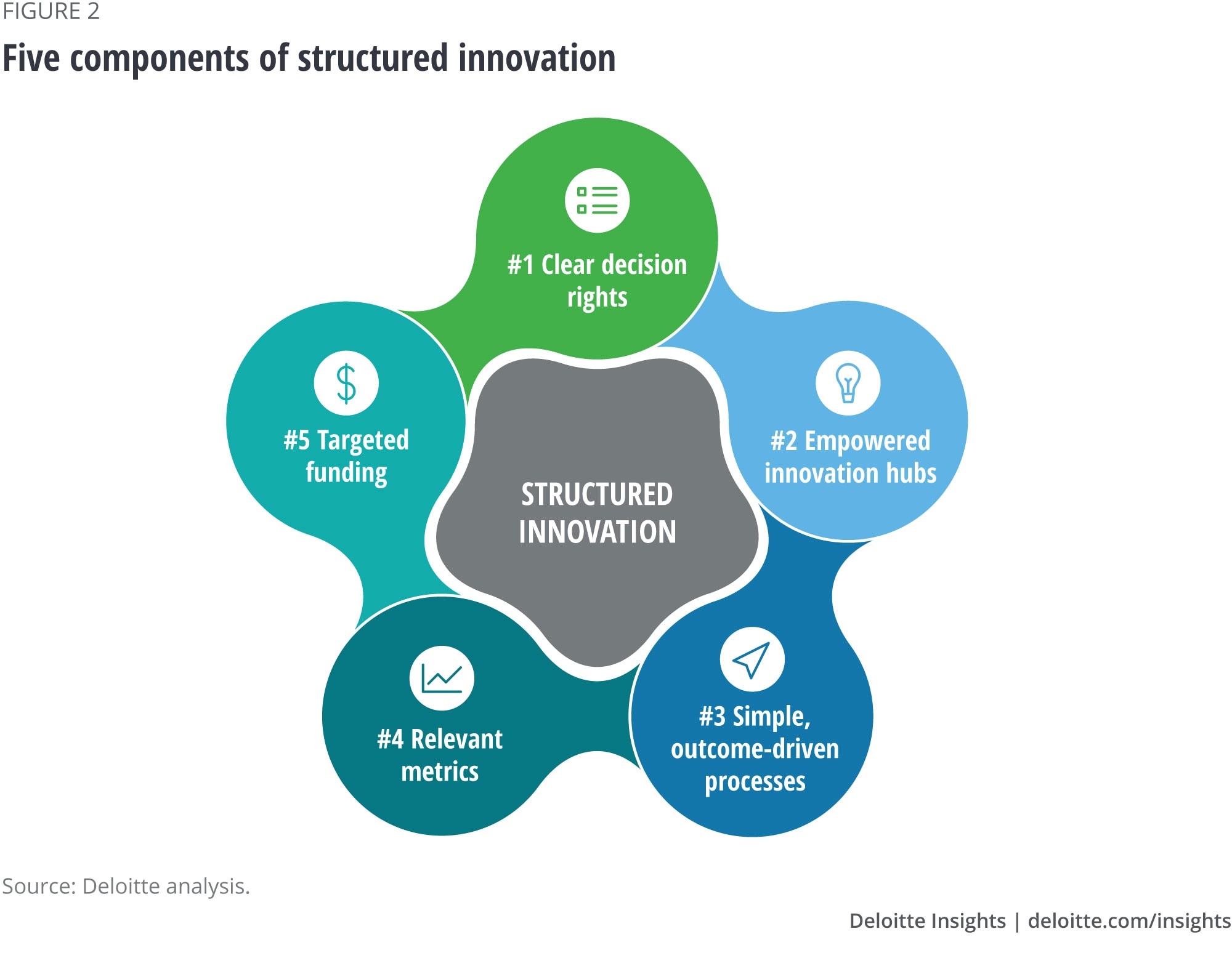
Clear decision rights
Companies typically manage innovation along a spectrum ranging from centralized to decentralized decision-making, often driven by the product portfolio’s diversity.
Leaders should be intentional in choosing a decision-making model, as each comes with its own benefits and challenges:
- Decisions made centrally, at a companywide level, can facilitate a more consistent customer experience but require greater executive time and lead to potential bottlenecks. A centralized model works best when the company is relatively small (fewer than 500 employees) and/or has a narrow set of products, innovation is focused on one or two product areas, and interoperability is of high priority. Such a model might work well, for example, in a pure-play storage hardware company.
- Decentralized decision-making, made at the product level, can facilitate more direct customer influence and a faster response to market changes but can lead to siloing and/or overlapping innovations and a less consistent experience. This model works best when the company operates a large, diverse portfolio, is targeting high growth across many product lines, and plans new products that require limited cross-pollination. A software company that has multiple discrete product lines serving different customers might employ a decentralized model.
- When decisions are made in a partially centralized manner—for example, at a business-line level—it can foster intentional collaboration and increased transparency and communication across business lines. However, this model requires compromise and a central group to facilitate coordination. In our experience, a partially centralized model works best when innovation is needed in two to five product areas, the desired innovation requires cross-pollination across established product lines, and product line leaders share similar priorities. A company that seeks to transform an entire product line, or to place big bets around an emerging technology, might employ a partially centralized model.
Empowered innovation hubs
Innovation often starts within a company’s core business but expands into adjacent markets and then, as capabilities mature, new markets and customers. Companies should look to conduct honest assessments of their innovation capabilities, empowering and investing in innovation “hubs” to meet their innovation goals. As such, innovation can be categorized across two dimensions: time horizon and proximity to core business.
For example, while product teams tend to focus on innovations within the core business, with tangible results and releases in the near term, R&D explores bigger, high-risk/high-reward ideas that may not yield benefits for years if at all (figure 3).
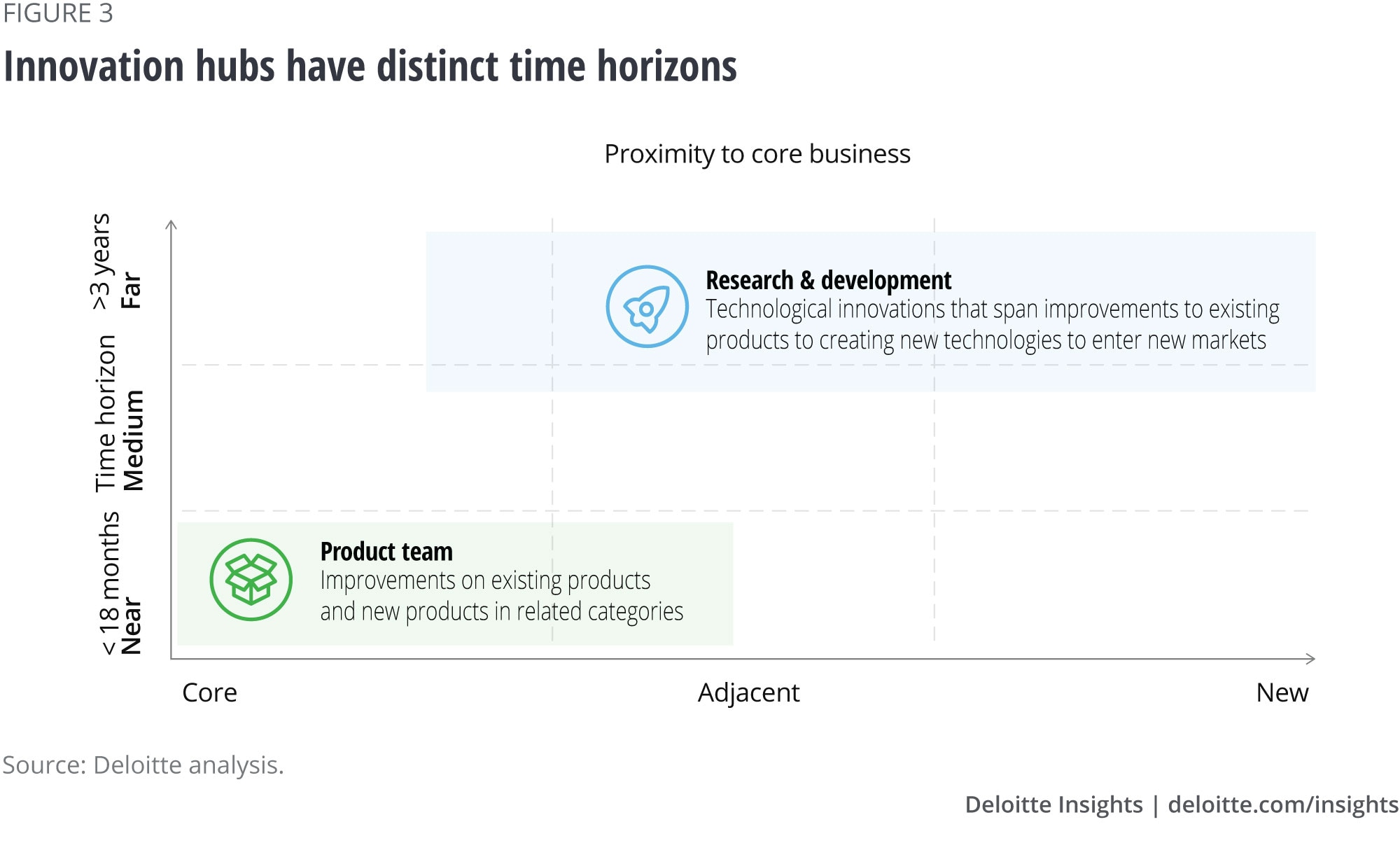
Based on its day-to-day work, each function within an organization may have an innovation sweet spot. Companies should identify and then empower the right innovation hubs based on their goals and available resources (figure 4). For example, if the goal is to introduce a new product to the market, the organization may want to create an incubator to accelerate the development of new, potentially disruptive product concepts.18 Case in point, Google created a separate R&D organization, X, to generate and test new, risky, value-creating ideas with the potential to become the next Google.19
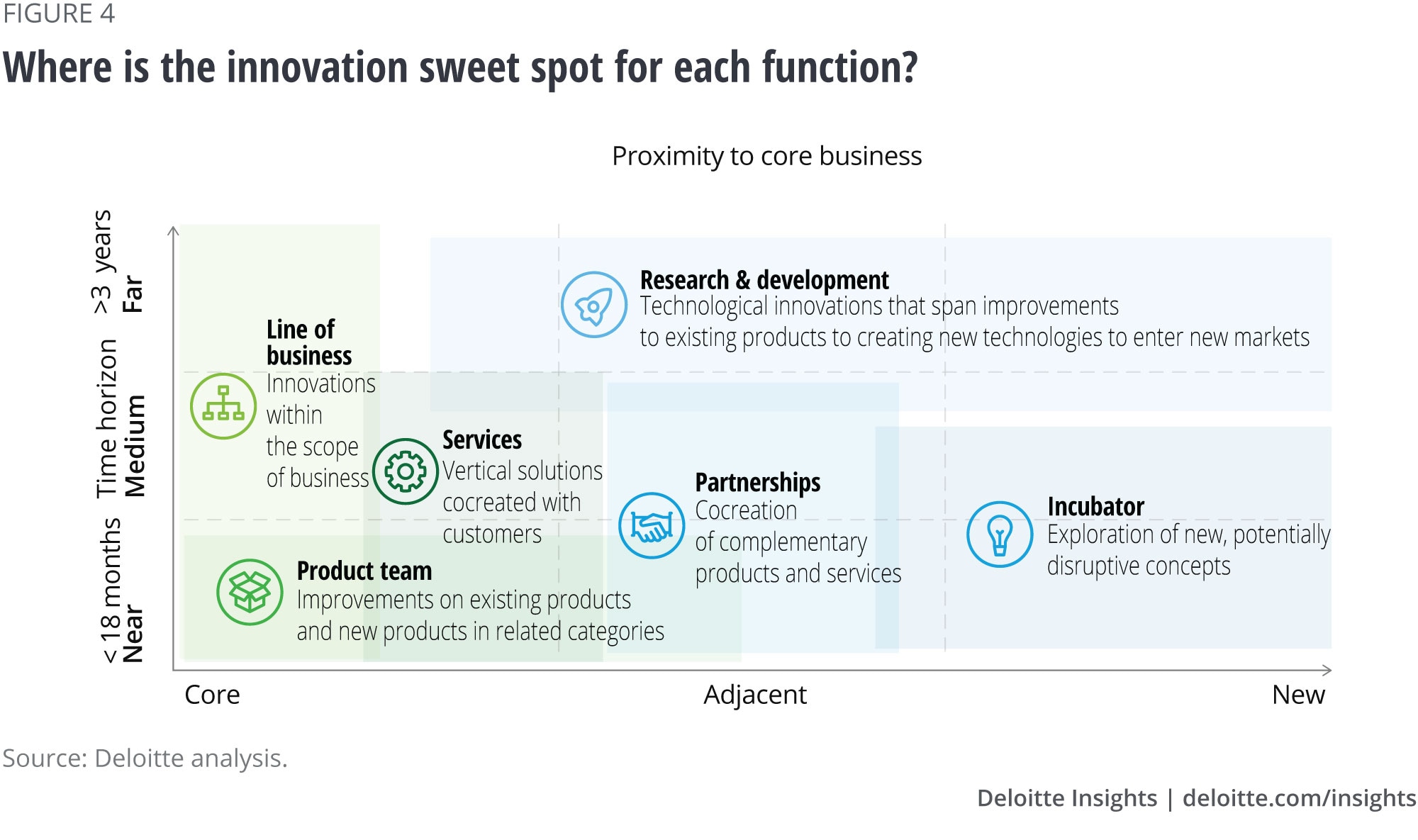
It is worth noting that successful innovation depends on the seamless flow of ideas and collaboration across teams. To maximize the flow of information and knowledge-sharing across teams, companies should ensure that their current tools and systems facilitate, rather than hinder, this type of collaboration.20
Successful innovation depends on the seamless flow of ideas and collaboration across teams.
Easy-to-follow and outcome-driven processes
Companies that are trying to rapidly innovate often struggle with how to effectively guide products from concept to commercialization. A well-designed product innovation process (figure 5) should be both business- and employee-friendly and include:
Clear stage-gates, in which new products are presented, evaluated, and approved for further activity or terminated, with a development process (including stage-gates) that is well understood within the company. For example, a global software company reviews new products and major releases of existing products at four distinct stage-gates during development. The appropriate number of stage-gates will depend on a variety of factors, such as decision-making model (centralized versus decentralized), risk tolerance, competencies, and company culture. A company with decentralized decision-making, high risk tolerance, and highly specialized product managers will likely need fewer stage-gates than a company with centralized decision-making, lower risk tolerance, and less specialized product managers.
Objective criteria, meaning a set of factual, measurable criteria to evaluate products at each stage-gate—thereby providing transparency to product teams, consistency within stage-gates, and minimizing bias in decision-making. For example, a global cloud infrastructure company evaluates new products using a predefined set of objective criteria at each “quadrant” of the development life cycle. The ideal criteria to use will vary depending on the development phase—in the early stages, an idea may be evaluated based on its potential market share. As development progresses, a new product might be evaluated based on evidence of its product-market fit as indicated by beta-test results and the number of customers converted from a pilot, as well as the feasibility of its business model.
Standardized templates for use by product teams preparing for each stage-gate, to minimize duplication of efforts and promote consistency and clarity across product teams. As noted earlier, as a result of its “working backwards” approach, Amazon uses the same three templates for each new product concept: a press release, FAQ list, and portrayal of the customer experience.
Of course, virtually every company screens ideas before testing, but companies should consider letting more through the process than might feel natural, since it’s easy for a product team to game the system—and thereby get the product past the first stage-gate—by manipulating a business plan’s numbers and data to make it look promising. Companies should determine who has the authority to review ideas at various stages of the development process, and then run small experiments to test whether a product idea is desirable, feasible, and viable.
This test-and-learn approach is embodied in the concept of agility, which prioritizes working iteratively in teams to build user-friendly, minimally viable products/offerings rather than end-state solutions, while ultimately delivering more value to customers through periodic updates.21 An agile approach to new product innovation may involve:
- Discovery, during which teams formulate and prioritize end-customer use cases with a preliminary go-to-market strategy and pitch these ideas
- Design, during which teams iteratively develop minimally viable products or offerings to demo
- Pilot, during which a minimally viable product is tested with users and feedback is collected and incorporated to improve and scale the product—or decide to halt further development
- Launch, during which the company introduces the product to one or more target markets
Each stage of development will require different deliverables (figure 5), depending on the product and the stage-gates as well as objective criteria that leaders have established.
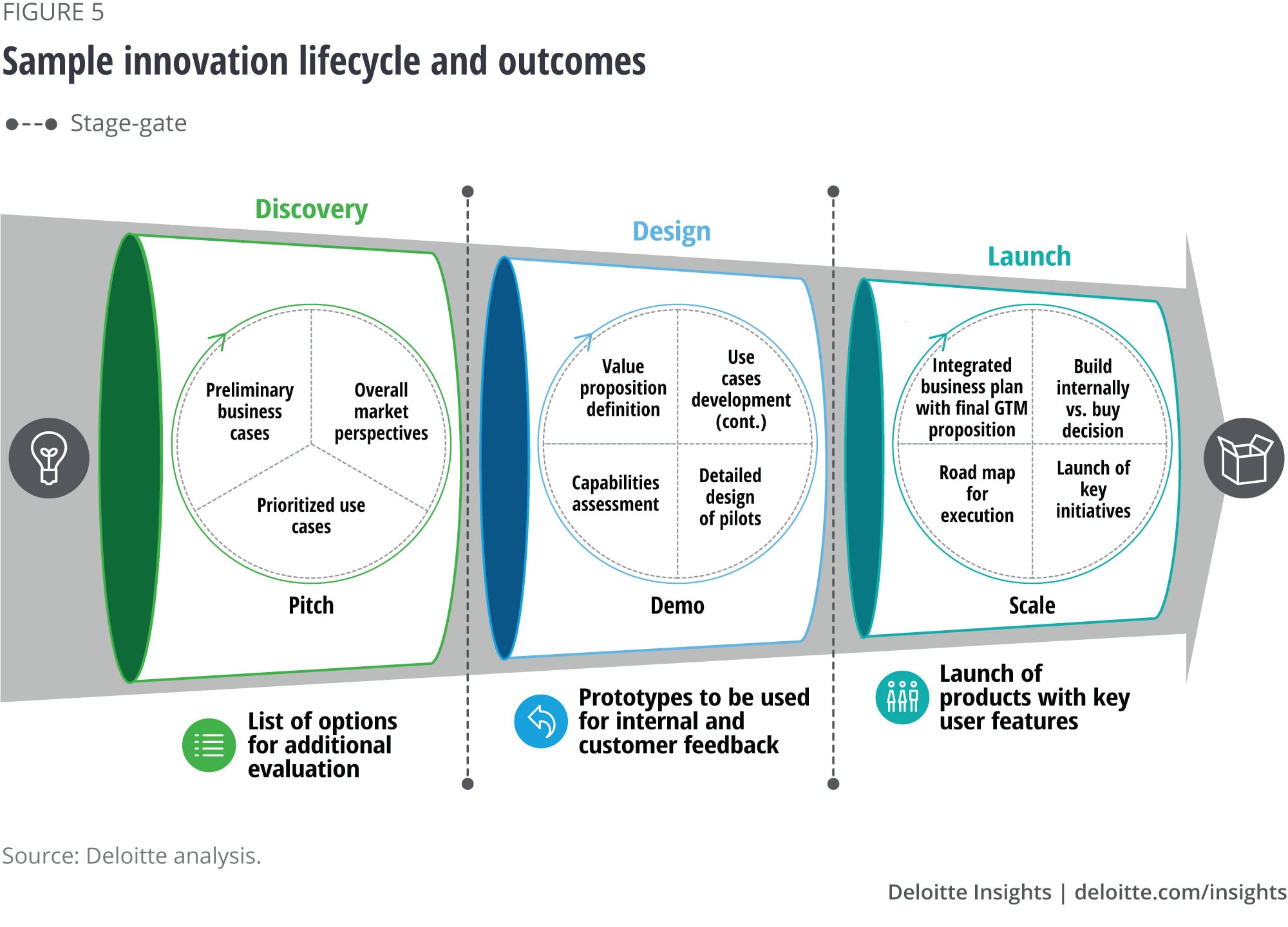
Once a product is launched, the company should continue to monitor progress, make enhancements where needed, and optimize/transform ongoing operations to support new product features and/or an evolving business model.
Relevant metrics
To properly track progress, companies should identify metrics that are both easy to calculate and align with the company’s strategic priorities. Companies should aim to measure both the success of individual products and overall innovation (figure 6) and evaluate the results through the lens of those priorities.
For example, if a company’s priority is to maximize the use of limited funds, it should focus on financial results, such as the total addressable market or ROI. Alternatively, if the company’s priority is to address new market needs, it should measure customer-centricity by looking at the percentage of new product concepts generated through customer interaction/feedback, or the percentage of customers converted from a product trial.
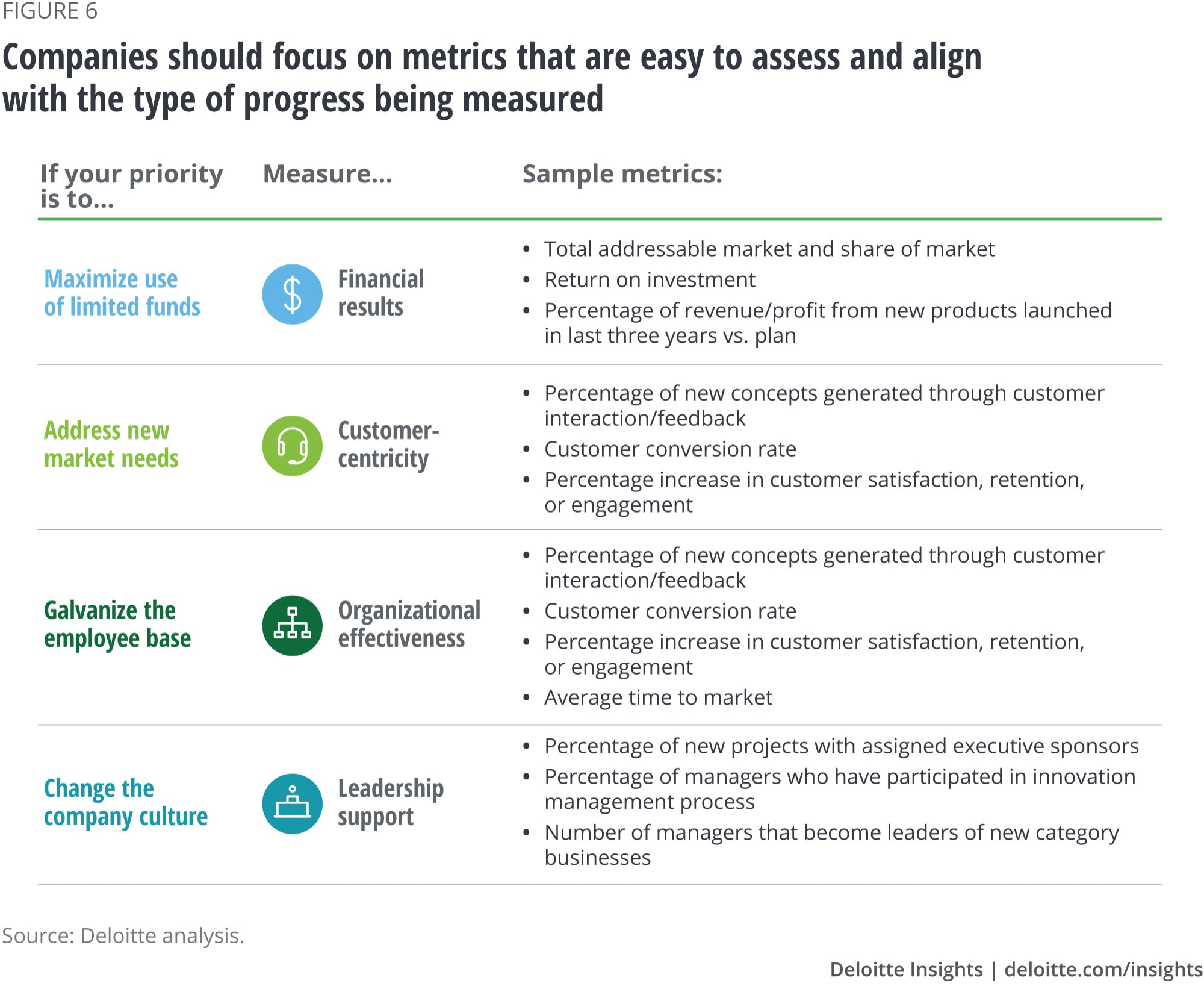
Targeted funding
Investment is, of course, a major constraint when it comes to innovation—companies require a robust, standardized framework to determine how opportunities should be funded. Based on their strategic goals, leaders should align on what percentage of resources to allocate across each of the following categories:
Innovation. These are strategic investments designed to explore new technologies that present future commercial opportunities, enable infrastructural change or process improvements, develop next-generation capabilities, or incubate future business—for example, R&D spend for products with a five-plus-year time horizon. A company focused on building and incubating new offers might allocate 40–50 percent investment to innovation, while a company focused on growth and productivity might allocate only 5–20 percent to innovation. One global retail company made strategic investments in predictive intelligence technology, which resulted in double-digit growth for the e-commerce business and spawned a research division that continues to generate high-impact solutions in inventory management, and delivery.
Growth. These are strategic investments designed to increase revenue and business size, transform core infrastructure to support new lines of the business model, or scale new lines of business—for example, systems to support a new business model, costs associated with entering a new market, or special marketing campaigns. A company focused on building and commercializing new product lines and services might allocate 40–50 percent investment to growth; a company focused on productivity and maintenance might allocate only 15–30 percent to growth.
Productivity. These are operational investments designed to improve margin and asset utilization or facilitate operational performance improvement of existing processes—for example, pricing optimization or systems to increase the sales force’s efficiency. A company focused on increasing effectiveness might allocate 30–40 percent investment to productivity; a company focused on growth and innovation might invest only 5–20 percent on productivity.
Maintenance. These are operational investments designed to maintain the functionality of infrastructure, reduce costs, and raise existing services’ quality and efficiency, or to prevent margin/market share erosion and asset deterioration—for example, security updates or customer retention programs. A company’s investment in maintenance will typically run 15–30 percent, depending on how it has prioritized innovation, growth, and productivity.
Leaders can then prioritize projects within each category and make the right investment decisions for their strategic goals.
Closing thoughts
As leaders prepare to meet the challenges of Industry 4.0, innovation management can provide a key source of differentiation by better aligning a company’s product, service, and solution portfolio with technology shifts, market trends, and customer needs. Our research suggests that companies that succeed at innovation leverage ideas from a variety of internal and external sources. Of course, the most effective deployment is within the broader context of digital industrial transformation, including defining the north star and strategic guardrails, aligning on the business models to support, and architecting a scalable enterprise operating model. By incorporating the five elements of structured innovation into broader corporate strategy, companies can position themselves for success in the digital industrial revolution.
© 2021. See Terms of Use for more information.
Explore more on Industry 4.0
-
Customer-centric digital transformation Article5 years ago
-
Scaling up anything as-a-service Article5 years ago
-
Industry 4.0’s impact on VAT/GST reporting and Compliance Article5 years ago
-
When the Internet of Things meets the digital supply network Article5 years ago
-
Aerospace & Defense 4.0 Article6 years ago
-
Building a cognitive digital supply network Article5 years ago
















